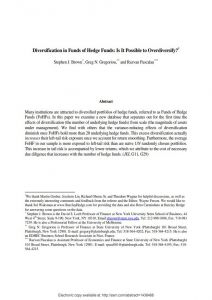

Diversification in Funds of Hedge Funds: Is it Possible to Overdiversify?
Samuelson (1967) argues that as a general matter it is easy to show that investors should be maximally diversified. For this reason many institutions are attracted to diversified portfolios of hedge funds, referred to as Funds of Hedge Funds (FOFs). In this paper we examine a new database that separates out for the first time the effects of diversification (the number of underlying hedge funds) from scale (the magnitude of assets under management). We find with others that the variance reducing effects of diversification peter out once FOFs hold more than 20 underlying hedge funds. Yet the majority of FOFs are more diversified than this. We find a new and surprising result that this excess diversification actually increases the left tail risk exposure of FOFs particularly once we account for the extent to which hedge fund returns are smoothed. A revisited version of this paper was published in the June 2012 issue of the Review of Asset Pricing Studies.
Author(s):
Summary:
Samuelson (1967) argues that as a general matter it is easy to show that investors should be maximally diversified. For this reason many institutions are attracted to diversified portfolios of hedge funds, referred to as Funds of Hedge Funds (FOFs). In this paper we examine a new database that separates out for the first time the effects of diversification (the number of underlying hedge funds) from scale (the magnitude of assets under management). We find with others that the variance reducing effects of diversification peter out once FOFs hold more than 20 underlying hedge funds. Yet the majority of FOFs are more diversified than this. We find a new and surprising result that this excess diversification actually increases the left tail risk exposure of FOFs particularly once we account for the extent to which hedge fund returns are smoothed. A revisited version of this paper was published in the June 2012 issue of the Review of Asset Pricing Studies.
| Type : | Working paper |
|---|---|
| Date : | 06/01/2011 |
| Keywords : |
Alternative Investments |

